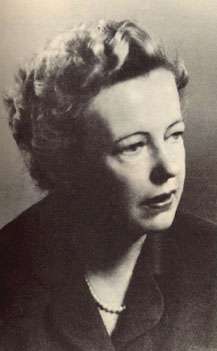| Maria Goeppert-Mayer  AKA Maria Göppert AKA Maria Göppert
Born: 28-Jun-1906
Birthplace: Kattowitz, Poland
Died: 20-Feb-1972
Location of death: San Diego, CA
Cause of death: Heart Failure
Remains: Buried, El Camino Memorial Park, San Diego, CA
Gender: Female
Race or Ethnicity: White
Sexual orientation: Straight
Occupation: Physicist Nationality: United States
Executive summary: Shell nuclear model Maria Goeppert-Mayer was born in Kattowitz, Germany (now Katowice, Poland), where her father was a progressive pediatrician who believed that girls and boys deserved equal opportunities. In childhood her family moved to Göttingen, where young Maria was sent to a girls' grammar school operated by suffragettes. The school went bankrupt after her junior year, but she passed a collegiate examination without a high school diploma and earned her PhD under Max Born at the University of Göttingen.
Women at the time were widely unwelcome in the upper realms of academia, and despite her doctorate for years she was largely confined to unpaid and unofficial work in university laboratories, her presence only accepted because her husband — Joseph Edward Mayer, a well-respected chemist who developed the Mayer expansion in statistical field theory — was on the faculty. Still, she wrote numerous papers on topics ranging from the color of organic molecules to beta ray decay to the behavior of uranium isotopes.
When her husband took a professor's post at Columbia University, she was engaged as lecturer for a single class in introductory chemistry. In that department she was drawn into the circle of scientists researching nuclear fission under Enrico Fermi. A colleague at Columbia, Harold C. Urey, asked her to work with his team on separating uranium-235 from the isotope uranium-238, as part of the American "Manhattan Project" effort to build an atomic bomb. Due to the classified nature of this work, she was unable to tell her husband about the specifics of her research until after the bombs were dropped on Japan. She said later that the weapons' devastation made her glad that her role in the project had been minimal.
In 1946 her husband took a post at the University of Chicago, where she was again limited to unpaid work in the laboratory and as a lecturer. Within a few months of her arrival, however, the Argonne National Laboratory was established near the university's campus, with Fermi, Urey, and Edward Teller, and Goeppert-Mayer was immediately hired as senior physicist. For the first time in her career, she was working and paid at a level commensurate with her training and expertise. Two years later she made the breakthrough that put her name among the most respected in her field.
With Teller, she conducted inquiries about the origin of the elements, and noticed the recurrence of seven "magic numbers", as she called them — 2, 8, 20, 28, 50, 82, and 126. Elements with a "magic number" of protons or neutrons were reliably more stable than elements with other numbers of protons or neutrons. Extrapolating from this, she proposed in that inside the nucleus, protons and neutrons are arranged in a series of nucleon layers, like the layers of an onion, with neutrons and protons rotating around each other at each level. At about the same time but working independently, German physicist J. Hans D. Jensen reached the same conclusion. For their work unravelling the structure of the atomic nucleus, Goeppert-Mayer and Jensen shared the 1963 Nobel Prize for Physics with Eugene Wigner.
In 1963 Goeppert-Mayer was awarded the Nobel honors in physics, and she is the namesake of the Maria Goeppert Mayer Award, presented annually by the American Physical Society to an outstanding woman physicist in the early years of her career. Her doctoral thesis predicted multi-photon absorption, the process in which two or more photons are absorbed by an atom simultaneously, and since this concept was proven in the 1960s the two-photon absorption cross section has been measured in Goeppert-Mayer (GM) units. She was deaf in one ear, and her left arm was paralyzed by a stroke in 1959. Father: Friedrich Goeppert (pediatrics professor, d. 1927)
Mother: Maria Wolff (piano teacher)
Husband: Joseph Edward Mayer (chemical physicist, b. 1904, m. 1930, d. 1983)
Daughter: Maria Ann Wentzel (astronomer, "Marianna")
Son: Peter Conrad (economist)
University: BS Physics, University of Göttingen (1928)
University: PhD Theoretical Physics, University of Göttingen (1930)
Scholar: Johns Hopkins University (1930-39)
Scholar: Special Alloy Metals Lab, Columbia University (1939-45)
Lecturer: Chemistry, Columbia University (1939-45)
Professor: Sarah Lawrence College (1942-45, concurrently with Columbia)
Teacher: Physics, University of Chicago (1945-59)
Professor: Physics, University of Chicago (1959-60)
Professor: University of California at San Diego (1960-72)
American Philosophical Society
American Physical Society
National Academy of Sciences
Naturalized US Citizen 1933
Manhattan Project 1942-45
Argonne National Laboratory 1946-59
Stroke 1959 (left arm paralyzed)
Nobel Prize for Physics 1963 (with Eugene Wigner, J. Hans D. Jensen)
Heart Attack 1971
Coma 1971-72 (after heart attack, until her death)
German Ancestry
Polish Ancestry
Units of Measure Goeppert-Mayer units (GM)
Venusian geography Goeppert-Mayer Crater (59.7° N, 26.8° E, 33.5 km. diameter)
Risk Factors: Deafness, Pacemaker, Smoking
Author of books:
Statistical Mechanics (1940, physics; with Joseph E. Mayer)
Elementary Theory of Nuclear Shell Structure (1955, physics; with J. Hans D. Jensen)
Requires Flash 7+ and Javascript.
Do you know something we don't?
Submit a correction or make a comment about this profile
Copyright ©2019 Soylent Communications
|